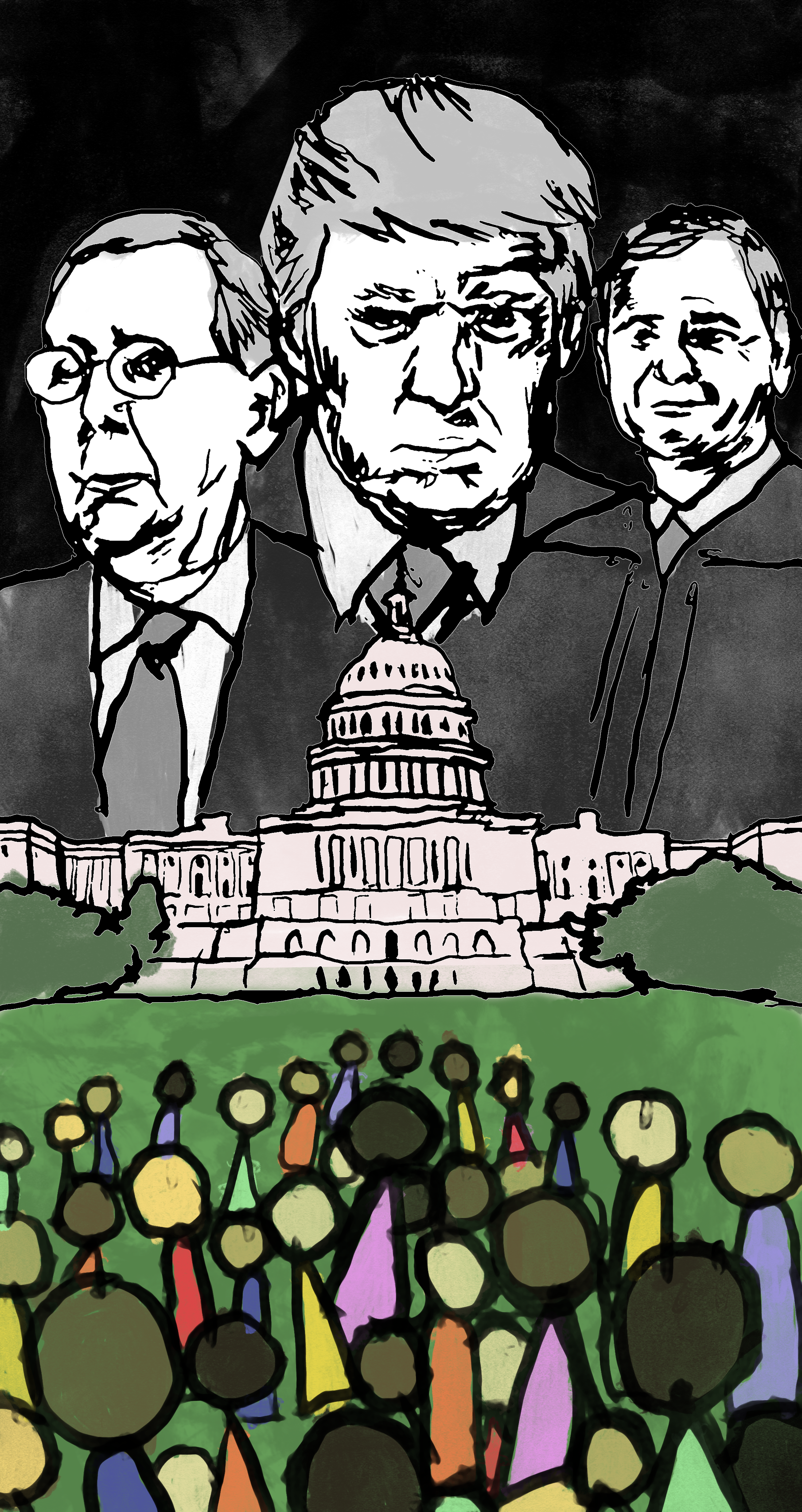Story by Amber Chen, Cat Flores, Katie Hohman, Adam Kwoh, Noah Kuhn, & Cloe Maurer
Opinion Editor, Editor-in-Chief, Staff Writer, Copy Editor, News Editor, & Feature Editor
Illustration by Nicholas Forman
Staff Illustrator
James Madison, the “Father of the Constitution,” made his anti-democratic viewpoints quite clear at the Constitutional Convention in 1787, stating “In England, at this day, if elections were open to all classes of people, the property of the landed proprietors would be insecure… Landholders ought to have a share in the government, to support these invaluable interests and to balance and check the other. They ought to be so constituted as to protect the minority of the opulent against the majority.”
In America’s checks and balances system, the executive branch enforces laws that the legislative branch creates and the judicial branch interprets. But, as Madison pointed out, this mantra of the three-branch system is really about keeping the “mob” in check and the “balance” of power in the hands of the one percent. In fact, a Princeton University study that examined 1,779 policy cases between 1981 and 2002 found that “overwhelmingly large pro-change majorities, with 80 percent of the public favoring a policy change, got that change only about 43 percent of the time.”
America is not a democracy. This country was designed as a plutocracy by the rich and for the rich and divide only continues to widen as corporations grow increasingly bloated. Tiger explores how this plutocracy continues
to pervade government and the structural changes that must be made to establish democracy.
Two-Party System
In the waning years of George Washington’s presidency, a two-party system began to emerge in its most nebulous form: Federalists and Democratic-Republicans. Washington warned against the fracture, predicting that it would widen and threaten the new country’s false democracy. His prediction was eerily correct and a democracy in shambles is the proof.
The two-party system reconfigured and contracted over the next two centuries and power ultimately consolidated in the Democratic and Republican parties. Unlike most developed nations, America has no influential Labor Party; in other words, there is no American political party that stands only to represent the interests of the people. This is an alarming oversight reflected very plainly in the relationships politicians on both sides of the aisle have with American corporations. “Pro-business,” a traditionally Republican platform, has taken on a whole new bipartisan meaning. Pro-business is now pro-corporation, something all pocket-lining politicians can get behind. Democrat Speaker of the House Nancy Pelosi took millions of dollars in donations from a health insurance provider and Republican Senate Majority Leader Mitch McConnell’s big donors are Wall Street firms. They are supposed political opposites, but they play the same corrupt systems for their personal gain.
Two ultra powerful parties are also two very vulnerable parties, hypersensitive to the politics of the elected rather than of the electorate. This is evident in the Overton window’s (If the political landscape was a sliding scale, the Overton window is the slider and it can move left or right and whatever falls within the confines of the slider is what is generally accepted by the public) dramatic rightward shift. Environmental preservation policies are now synonymous with the Democratic Party when it was Nixon who formed the EPA 50 years ago, and the Republican Party’s loudest voice is an alarmingly and unabashedly bigoted president who refuses to denounce white supremacy. Democrats failed to act on legislation like The Employee Free Choice Act which would protect the right to unionize and impact the private sector, in other words, big corporate donors, the most.
When the topic of Donald Trump’s $750 federal income tax was raised during last week’s debate, he spluttered that Joe Biden created those tax loopholes in the form of a post recession bill designed to alleviate business loss burdens. While this is not entirely factual, it does brush up against a larger idea about where Democrats’ priorities lie. Like Republicans, they are willing to uphold laws that benefit corporations, specifically when their wealthy owners are also their donors. Super pacs and lobbyists allow politicians to be bought and this is reflected in how much corporations spend on lobbying: around $2.6 billion per year.
Moderate Democrats are the most influential Democrats in Congress. They are also often the deepest in bed with their corporate donors and are willing to hinder progress for their donors’ benefit. The Democratic National Convention consistently puts forward moderate presidential candidates like Joe Biden that don’t represent more progressive Democratic voters, but the only other option is to support a right wing extremist Republican party. Of course, third-parties do technically exist, but they hold no real sway. A third-party candidate has never won the presidency and anyone, like Bernie Sanders, who wants a real shot at being elected runs with the Democratic party.
The two-party system ladles power into the hands of the economic elite and forces voters to rally behind candidates that do not stand to meet their needs or protect their rights. Lobbying and super-pacs must be banned in order to disincentivize favoring the wants of corporations and the uber-rich over the needs of the people. The two-party system is an unproductive and undemocratic basis for democracy and must be broken down in order for a truly representative system that prioritizes principle regardless of party to take form.
Judicial Branch
The Judicial Branch, which was created to ensure justice and equality and curtail tyrannical leaders, has devolved into an isolated body with too much power. The limits of the courts, which were originally put in place to limit corruption, have stripped the body of its ability to truly represent the people.
Within the branch, nine justices are granted almost unlimited power and are responsible for upholding the rights of all citizens. Those justices do not accurately represent the diversity of the American people. Currently, five of the eight justices are white men, but have been given the power to carry out rulings that affect millions of people from different backgrounds.
The court system has always been this way. In the decision of Roe v. Wade (1971), all of the justices were men but the case was specific to the reproductive rights of women. In Obergefell v. Hodges (2015), which legalized same-sex marriage, none of the justices were members of the LGBTQ+ community. It can be painful to sit and watch nine justices appointed during a bygone era argue over the rights of people who have no say in the final decision.
One key way to combat that issue is to expand the number of justices on the Supreme Court. Instead of relying on nine people to make fair decisions, having more people in charge of the rights of all will allow for a more fair distribution of power. More justices also opens up the possibility of more diversity of opinion on the bench, allowing the American people to feel more represented.
With the death of Ruth Bader Ginsburg, more people have begun to re-evaluate the power that the Supreme Court has and what led to the future of our democracy resting on the shoulders of one 87-year old woman. In response to those concerns and the confirmation of Amy Coney Barrett, House Democrats proposed a 18-year term limit for Justices.
This proposition makes sense, as a life term is far too long for any one person to be in politics and only leads to the appointment of justices that are older and have lost touch. Having such long terms discourages the appointment of young justices who may not be ready to commit to such a position for that long.
Abolishing the life term for Supreme Court justices and replacing it with a staggered 18-year term limit will keep the Justices current and create a less isolated court system. It will allow the American people to be better connected with the Supreme Court and create a judicial branch that best represents the people.
Legislative Branch
The U.S. Congress is composed of two bodies: the Senate and the House of Representatives. Americans are represented proportionally based on population in the House of Representatives, however each state — no matter if it has half a million or 40 million inhabitants — receives two Senators. This bicameral legislature represents a compromise between democracy and long lasting systems of oppression in the U.S. The Senate is the embodiment of the white, wealthy patriarchy and true democracy can only be achieved if it is abolished.
In 1787, 55 elite white men met in Philadelphia to establish the framework for the newly independent nation: the Constitution. While these “Founding Fathers” claimed to have the will of the people in mind, the government
they established intentionally favored themselves. As written in Madison’s Federalist 10, the founders believed “that measures are too often decided not according to… the rights of the minor party” and that the minority rights must be protected. However, at the time the minority were the wealthy white property owners who the founders themselves belonged to. The Senate was designed to protect the founders’ fears of “the majority faction” and continues to do so at the expense of women, poor people, and BIPOC.
Proof of the Senate upholding white supremacy, sexism, and elitism lies no further than a brief analysis of the governing body’s current members. 74 of the 100 Senators are male, even though men make up only 49.2 percent of the U.S. population. Even in 2020, there are only 10 BIPOC Senators which is four times less than the percentage of people of color in the U.S.
Each state having two Senators heavily favors states with much smaller populations, which almost always have fewer BIPOC. The around 90 percent white residents of states like Wyoming, North Dakota, Idaho, and Utah are vastly overrepresented in Congress as compared to the much more racially diverse populations of states like California and New York. The Senate ensures that even as more BIPOC move into the U.S., white people will continue to hold more political power. Such a fundamentally racist system cannot be reformed but must be abolished to achieve racial equity.
The Senate has long held the most power and influence in Congress because it is the only body that confirms presidential and judicial appointments. However, it is also notorious for prolonging deliberation and preventing important bills from passing due to the Majority Leader’s supreme power to control what Senators vote on and the legislators’ ability to filibuster — a common stalling tactic employed by the Senators.
In comparison, the House of Representatives can move bills much faster because once they reach the House floor there is no filibuster to leave bills in limbo. Shorter terms of two years compared to the Senate’s six also limit the potential for corruption and allow for representation and policy ideas to stay current.
The people already have their voice represented in the House of Representatives, albeit with some major flaws like gerrymandering and a history of appealing to slave states in the three-fifths compromise. The Senate only dilutes and hinders democracy to keep rich white men and their corporations in power. If America is truly the great democracy it claims to be, it needs to end its root of oppression and corruption in government by abolishing the Senate.
Executive Branch
The Founders created the executive branch to provide effective and intelligible leadership. However, it has become apparent that the executive branch’s structure enables tyranny, the exact thing the Founders claimed to fear, and falsifies the American government’s promise to uphold a true democracy.
Donald Trump’s reign as president has exposed the issues within the executive branch that have existed since its creation. Firstly, he is a president who gained office through the electoral college — the root of the executive branch’s flaws — even though he lost the popular vote. This has happened twice in this millennium alone, with the election of George W. Bush in 2000 and Trump in 2016.
The Electoral College is a body of electors established by the United States Constitution, which convenes every four years for the sole purpose of electing the president and vice president. It emphasizes the stark reality of America’s pseudo-democracy.
For one, the Electoral College gives disproportionate voting power to small states, handing them more electoral votes per a person. For example, a voter in Wyoming has about 3.7 times the three electoral power versus someone living in California.
Furthermore, through the Electoral College, people are not voting directly, but rather, telling their state how to use its electoral votes. For example, when a candidate wins the majority of votes in Florida, no matter how small the majority, they get all of Florida’s votes. But, minority rule should have no place in democratic elections; the very definition of democracy implies a majority rule.
Not only is the Electoral College inherently undemocratic, but the president wields an unfathomable amount of power. The cabinet should not be appointed, it should be composed of authorities in their respective field.
Trump has stocked his cabinet full of his own family members and other highly unqualified individuals such as Ben Carson, a neurosurgeon, in Housing and Urban Development. This is clearly not in the best interest of our country, but in the interests of his party.
The president also should not be able to veto laws. Congress rarely overrides a veto; Out of 1,484 vetoes since 1789, only 7.1 percent have been overridden. This is because Congress can only override a veto by passing an act with a supermajority in both the House and the Senate. It is difficult enough for lawmaking bodies to pass laws in the first place and one person should not be able to override other elected bodies.
Furthermore, the president and vice president should be covered in the federal conflict of interest statute or the federals ethics disclosure. This is necessary in making sure there are no conflicts of interest and increasing transparency. For example, the fact that Trump kept his tax returns a secret from the public — until they were leaked — was shockingly legal. Information recovered revealed that Trump has acquired massive debts and the public is not required to know who he owes money to, even though there could be serious conflicts of interest at hand.
The current structure of the executive branch is a direct assassination on democracy. The Electoral College must be abolished and executive office holders must be held accountable by the American public.



